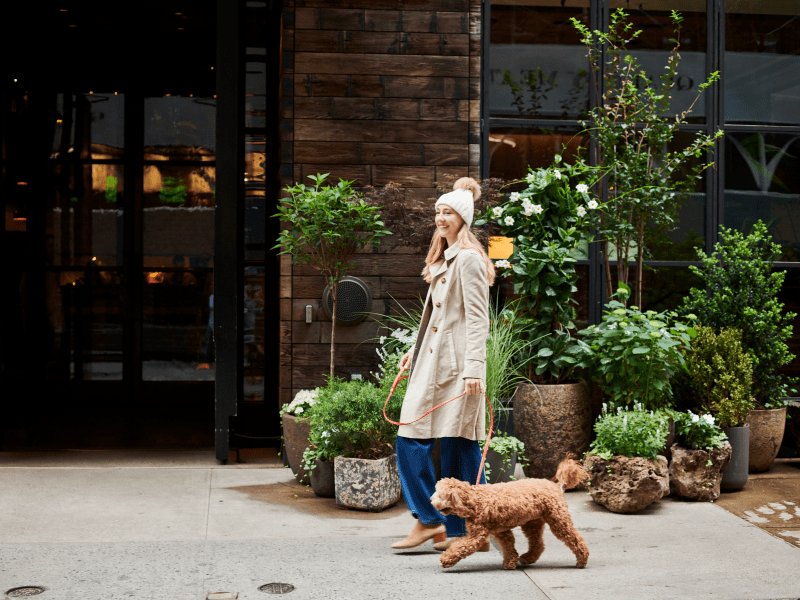From Gloom to Bloom: How You and the Planet Can Nurture Each Other Through the Winter Blues
Winter has arrived, and although it brings about a period of serene stillness and meaningful pause, it can also bring about feelings of sadness and loneliness. In the US alone, seasonal affective disorder (SAD) can affect roughly 5% of the population and last for up to 40% of the year.

While the shortened sunlight, colder temperatures, and bare trees might tempt you to stay inside, we’re here to remind you that you can lean on the natural world this winter—and it might just inspire you to do more to safeguard the planet. To get you started, we’re sharing our top tips for getting out in nature (or bringing it indoors) to brighten up your day.
REGULATE YOUR INTERNAL CLOCK, NATURALLY
Experts agree that limited sunlight during the winter months can have huge impacts on your sleep cycle. As nighttime seems to creep earlier and earlier, it’s more important than ever to check in with your biological clock to soften the blow of SAD.
To regulate your circadian rhythm naturally, try to get sunlight in your eyes first thing in the morning. Maybe this means enjoying your morning beverage on the patio, grounding your feet in the grass or sand, or going for a leisurely stroll before you dive into your day. On a similar note, it’s important to get out again before dusk to savor every second of sunlight and prime your body to produce melatonin for a restful night’s sleep. The act of recalibrating your circadian rhythm via sunlight is an amazing example of how our bodies are so intertwined with nature’s cues.
In between morning and sunset, you should aim to get in at least 30 minutes of mindful movement, as it has the power to reduce your stress, uplift your mood, reset your internal clock, get rid of “bottled up” energy (especially if you're mostly sedentary throughout the day), and prime your body for sleep. Perhaps most importantly, mindful movement has the power to align your mind and body. We tend to spend so much time focusing on things that distract us from our internal sensations, and mindful movement can bring you back to a place of synergy—and gratitude for your body and the way it beautifully adapts to the seasons.
BRING THE OUTDOORS IN
No matter where you are (but especially those who experience bitter cold weather in the winter), we highly recommend bringing the outdoors in. This is a core design ethos across our sanctuaries, where biophilic design can bring you closer to nature in unexpected ways. By bringing the elements of Mother Earth inside, you can calm your nervous system, inspire mindfulness, ease your stress and anxiety, purify your space, reconnect to your roots, and so much more.
You can explore our previous article to get expert advice on how to liven up your space from the founder of Plant the Future, Paloma Teppa. She explains, “The easiest way to bring nature indoors is through live plants. Plants serve as healers and air purifiers, bringing positive energy and serenity to your space.” If you’re feeling especially inspired, you can follow our how-to guide on creating your very own plant wall.
Paloma also describes how infusing natural fibers, textures, and smells throughout your spaces can enhance positive energy and serenity. Research reveals that aromatherapy may have the power to soothe symptoms of depression, anxiety, and sleep disorders—another indication that nature is a profound healer. You can experience the benefits of aromatherapy through our natural Kindling Candle or through essential oils, electric diffusers, and reed diffusers.
EMBARK ON A WINTER ADVENTURE
Winter adventures have the power to rejuvenate and energize your soul to combat the winter blues. Whether it’s a trip to one of our sanctuaries or a few hours exploring a new nature nook in your area, we’ve outlined a few of our favorite ways to make the most of the season.
- Plan a trip to a new place. Research shows that exploring new places isn’t only exciting, it actually has the potential to rewire your brain and inspire optimism by exposing you to new areas and cultures. Across our sanctuaries, we’ve programmed thoughtful daylife events that get you connected to the local environs and culture to make the most of every day, no matter the season.
- On a sunny day, get out in a new area of nature. We’re creatures of habit, so we all tend to have our go-to walking spots and routes already queued up. But just like traveling, research supports that keeping your world “big” by exploring new areas or simply choosing a different route can improve your brain health by taking you out of auto-pilot. Taking new paths allows you to discover new things, cultivate creative inspiration, tap into your consciousness, and cherish the present moment surrounded by natural beauty.
- Take your mindful movement outside. If you live in an area with milder winter weather (or you don’t mind the cold), we encourage you to complete your daily workout in nature. Outdoor exercise can further revitalize your spirit and energy while simultaneously aligning your internal clock. Consider yoga on the deck, a hike through the woods, a walk on the beach, a jog through the park, skiing/snowboarding down your favorite mountain, or even sledding to get back in touch with your childlike wonder.
- Plan a short visit to an old friend. Colder weather and SAD can feel isolating, so it’s important to prioritize socializing now more than ever. If your closest friends are far away, try to plan a joint self-care day over video call to share an uplifting experience (like finally creating that plant wall together!).
Winter adventures don’t have to be grand, yet they still have the potential to impart amazing benefits during a slow, still season.
HOW THESE HABITS CAN SUPPORT NATURE IN RETURN
In their own unique way, each of these core habits brings you closer to nature to uplift your spirits and inspire mindfulness in your everyday life. It’s important to remember that our relationship with nature is symbiotic. In other words, it’s a two-way street—as nature benefits us, it’s up to us to do our part to support it.
The core beliefs of traditional meditation suggest that we are made up of natural elements, and being closer to these elements allows us to bring balance to our mind and body. It also suggests that once we acknowledge our reliance on nature to feel this internal peace, we feel a deeper obligation to care for nature. Research has also revealed that mindfulness can contribute significantly to sustainability consciousness. Our experience confirms this—simply feeling and acknowledging how elements of nature can soothe our sensations (from everyday stress to seasonal depression) can inspire us all to do our part in safeguarding the planet.













